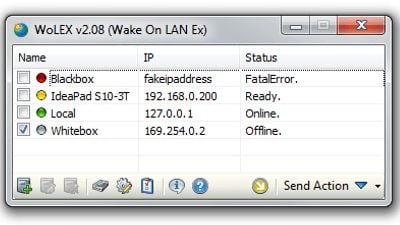

On the status bar at the bottom, it reads Magic Packet Sent To 255.255.255.255. Input the MAC Address, Internet Address (local address in this case), Subnet Mask, Send Options: Local Subnet, Port Number 7 (default port), and then click the Wake Me Up button.

You'd have to worry about which version of what shell everyone has to have any hope - it wouldn't be portable. The screenshot below shows the use of the Depicus Wake On LAN GUI.
#WOL MAGIC PACKET SENDER PORTABLE WINDOWS 7#
I have tried Wake-on-LAN Packet Sniffer 1.1 on Windows 7 and used the Wake-on-LAN Packet sender of the same vendor (Power Management Software). Shells aren't equipped to deal with binary data. As I explained in my article about the free SolarWinds Wake-on-LAN tool, Magic Packets consist of six bytes of 255 (hex FF) followed by sixteen repetitions of the target computer’s MAC address. This packet communicates directly with the motherboard of the machines and sends a power-on command to the device, as long as the machine is configured to do so in BIOS.

Lots of shells don't even have /dev/udp - despite the name, there is no /dev/udp, that's a shell extension in a few specific versions of KSH and BASH.įurthermore, a magic packet is going to be difficult to craft in a shell. As long as a machine is accessible from the LAN, it can be turned on through the use of what is called a magic packet.
#WOL MAGIC PACKET SENDER PORTABLE SOFTWARE#
Best software by Zwalisoft WOL Magic Packet Sender FREE Download 16 WOL Magic Packet Sender is a program that provides you with remote access to the computers. So that rules out /dev/udp tricks as well. The most popular software is WOL Magic Packet Sender with 16 installations on Windows PC. I don't think writing to the broadcast address is enough these days, it has to be sent with the special BROADCAST flag. It has to be a broadcast because, without an IP, you have no way to "aim" the packet at anyone. UDP is more like ping, where it just gets sent no matter what.īut it takes a very specific kind of UDP packet to reach a sleeping machine: A broadcast UDP packet. Things like telnet, ftp, etc mostly use TCP connections, which depend on the machine being awake to respond. 1) You can't make TCP connections to a machine that's asleep.Ģ) You can't even aim at a machine that's asleep - by definition, it doesn't have an IP yet.


 0 kommentar(er)
0 kommentar(er)
